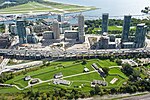Sir Isaac Brock Bridge

The Sir Isaac Brock Bridge is a steel Warren truss bridge in Toronto, Ontario, Canada. It lies along Bathurst Street over the railway tracks between Front Street and Fort York Boulevard. The bridge carries four lanes for motor vehicles with the centre lanes containing the streetcar tracks of the Toronto Transit Commission's 511 Bathurst streetcar route. The Bridge was formerly named The Bathurst Street Bridge before changing names and being named after Isaac Brock. The steel truss bridge was built in 1903 and used for the Great Western Railway over the Humber River (northside of then Lakeshore Road at mouth of the river). It was dis-assembled and re-located in 1916 to Bathurst Street and converted for road traffic. The bridge served to connect Bathurst Street at Front Street to Fort York.In 1931, the bridge was moved and re-aligned (Bathurst Street was at an angle south of Front Street) to support streetcar service south of the railway tracks at that location. A new bridge south of the bridge was constructed to connect the south end of the bridge, connecting Bathurst to Fleet Street. Fort York lost its road access in the change, and a footbridge to the east entrance was constructed.The Tywn River Drive Bridge, Queen Street Viaduct, and the Old Eastern Avenue Bridge are other examples of steel bridges in Toronto. Lawrence Avenue Bridge was a truss bridge that took traffic over Don River, but it was replaced by the current overpass over the Don River and Don Valley Parkway in the 1960s. In 2007, the bridge was given the official name of the "Sir Isaac Brock Bridge" by the City of Toronto. This was done at the instigation of the "Friends of Fort York" organization. The bridge is owned by Metrolinx, which owns the railway tracks below. It was formerly owned by the Canadian National Railway.From May until late-December 2020, the bridge was closed for rehabilitation work. Crews made steel and concrete repairs to the road-carrying spans and the exposed steel, replaced TTC streetcar tracks and overhead wiring, and constructed a new concrete parapet wall along the curb for improved safety.
Excerpt from the Wikipedia article Sir Isaac Brock Bridge (License: CC BY-SA 3.0, Authors, Images).Sir Isaac Brock Bridge
Bathurst Street, Toronto
Geographical coordinates (GPS) Address External links Nearby Places Show on map
Geographical coordinates (GPS)
| Latitude | Longitude |
|---|---|
| N 43.640357 ° | E -79.40127 ° |
Address
Sir Isaac Brock Bridge
Bathurst Street
M5V 0E7 Toronto
Ontario, Canada
Open on Google Maps









